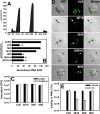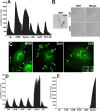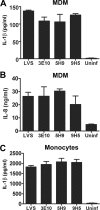Francisella tularensis genes required for inhibition of the neutrophil respiratory burst and intramacrophage growth identified by random transposon mutagenesis of strain LVS
- PMID: 19204089
- PMCID: PMC2663180
- DOI: 10.1128/IAI.01318-08
Francisella tularensis genes required for inhibition of the neutrophil respiratory burst and intramacrophage growth identified by random transposon mutagenesis of strain LVS
Abstract
Francisella tularensis is a facultative intracellular pathogen and the causative agent of tularemia. We have shown that F. tularensis subspecies holarctica strain LVS prevents NADPH oxidase assembly and activation in human neutrophils, but how this is achieved is unclear. Herein, we used random transposon mutagenesis to identify LVS genes that affect neutrophil activation. Our initial screen identified carA, carB, and pyrB, which encode the small and large subunits of carbamoylphosphate synthase and aspartate carbamoyl transferase, respectively. These strains are uracil auxotrophs, and their growth was attenuated on cysteine heart agar augmented with sheep blood (CHAB) or in modified Mueller-Hinton broth. Phagocytosis of the uracil auxotrophic mutants triggered a respiratory burst in neutrophils, and ingested bacteria were killed and fragmented in phagosomes that contained superoxide. Conversely, phagocytosis did not trigger a respiratory burst in blood monocytes or monocyte-derived macrophages (MDM), and phagosomes containing wild-type or mutant bacteria lacked NADPH oxidase subunits. Nevertheless, the viability of mutant bacteria declined in MDM, and ultrastructural analysis revealed that phagosome egress was significantly inhibited despite synthesis of the virulence factor IglC. Other aspects of infection, such as interleukin-1beta (IL-1beta) and IL-8 secretion, were unaffected. The cultivation of carA, carB, or pyrB on uracil-supplemented CHAB was sufficient to prevent neutrophil activation and intramacrophage killing and supported escape from MDM phagosomes, but intracellular growth was not restored unless uracil was added to the tissue culture medium. Finally, all mutants tested grew normally in both HepG2 and J774A.1 cells. Collectively, our data demonstrate that uracil auxotrophy has cell type-specific effects on the fate of Francisella bacteria.
Figures






Similar articles
-
Francisella tularensis LVS evades killing by human neutrophils via inhibition of the respiratory burst and phagosome escape.J Leukoc Biol. 2006 Dec;80(6):1224-30. doi: 10.1189/jlb.0406287. Epub 2006 Aug 14. J Leukoc Biol. 2006. PMID: 16908516 Free PMC article.
-
Identification of transposon insertion mutants of Francisella tularensis tularensis strain Schu S4 deficient in intracellular replication in the hepatic cell line HepG2.BMC Microbiol. 2006 Jul 31;6:69. doi: 10.1186/1471-2180-6-69. BMC Microbiol. 2006. PMID: 16879747 Free PMC article.
-
EmrA1 membrane fusion protein of Francisella tularensis LVS is required for resistance to oxidative stress, intramacrophage survival and virulence in mice.Mol Microbiol. 2014 Mar;91(5):976-95. doi: 10.1111/mmi.12509. Epub 2014 Feb 8. Mol Microbiol. 2014. PMID: 24397487 Free PMC article.
-
Live Attenuated Tularemia Vaccines for Protection Against Respiratory Challenge With Virulent F. tularensis subsp. tularensis.Front Cell Infect Microbiol. 2018 May 15;8:154. doi: 10.3389/fcimb.2018.00154. eCollection 2018. Front Cell Infect Microbiol. 2018. PMID: 29868510 Free PMC article. Review.
-
Multifaceted effects of Francisella tularensis on human neutrophil function and lifespan.Immunol Rev. 2016 Sep;273(1):266-81. doi: 10.1111/imr.12445. Immunol Rev. 2016. PMID: 27558340 Free PMC article. Review.
Cited by
-
Persistence versus escape: Aspergillus terreus and Aspergillus fumigatus employ different strategies during interactions with macrophages.PLoS One. 2012;7(2):e31223. doi: 10.1371/journal.pone.0031223. Epub 2012 Feb 3. PLoS One. 2012. PMID: 22319619 Free PMC article.
-
Francisella tularensis DeltapyrF mutants show that replication in nonmacrophages is sufficient for pathogenesis in vivo.Infect Immun. 2010 Jun;78(6):2607-19. doi: 10.1128/IAI.00134-10. Epub 2010 Apr 12. Infect Immun. 2010. PMID: 20385757 Free PMC article.
-
Francisella tularensis metabolism and its relation to virulence.Front Microbiol. 2010 Dec 24;1:140. doi: 10.3389/fmicb.2010.00140. eCollection 2010. Front Microbiol. 2010. PMID: 21687763 Free PMC article.
-
The Ability to Acquire Iron Is Inversely Related to Virulence and the Protective Efficacy of Francisella tularensis Live Vaccine Strain.Front Microbiol. 2018 Apr 4;9:607. doi: 10.3389/fmicb.2018.00607. eCollection 2018. Front Microbiol. 2018. PMID: 29670588 Free PMC article.
-
Multiple mechanisms of NADPH oxidase inhibition by type A and type B Francisella tularensis.J Leukoc Biol. 2010 Oct;88(4):791-805. doi: 10.1189/jlb.1209811. Epub 2010 Jul 7. J Leukoc Biol. 2010. PMID: 20610796 Free PMC article.
References
-
- Allen, L.-A. H., B. R. Beecher, J. T. Lynch, O. V. Rohner, and L. M. Wittine. 2005. Helicobacter pylori disrupts NADPH oxidase targeting in human neutrophils to induce extracellular superoxide release. J. Immunol. 1743658-3667. - PubMed
-
- Allen, L.-A. H., and R. L. McCaffrey. 2007. To activate or not to activate: distinct strategies used by Helicobacter pylori and Francisella tularensis to modulate the NADPH oxidase and survive in human neutrophils. Immunol. Rev. 219103-117. - PubMed
Publication types
MeSH terms
Substances
Grants and funding
LinkOut - more resources
Full Text Sources
Other Literature Sources

